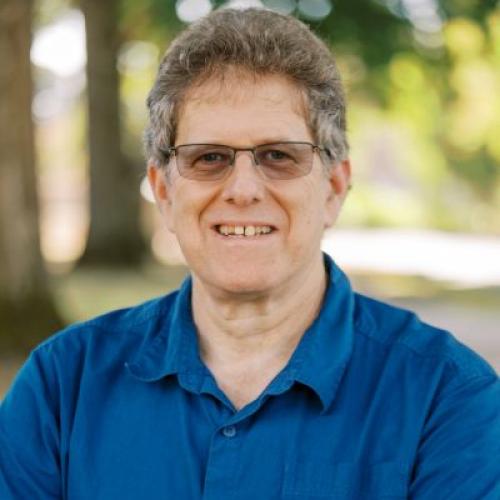
Fried, Jeremy
Position Type:
Faculty
Job Title:
Courtesy Faculty; Research Forester, USDA Forest Service
Department:
Forest Engineering, Resources & Management
Phone Number:
Email:
Website:
Education
PhD, 1992, Wildland Resource Science, University of California - Berkeley
M.S., 1985, Forest Management, Oregon State University
B.S., 1982, Forestry, University of California - Berkeley
Research Areas
Science of Conservation, Restoration and Sustainable Management
Silviculture, Fire, Forest Health and Biodiversity
Forest Operations Planning and Management
Research Interests
- Biometrics
- Forest Management
- Forest Modeling
- Forest Resources
Research questions centered on management of U.S. forests and wildlands, informed by inventory science and data, pique my interest. I seek to better understand and share insights about management’s efficacy and impact on fire resistance and delivery of climate benefits as in-forest sequestration and in the storage and substitution benefits generated by wood products. Innovative silviculture combined with creative development of markets for woody biomass of all kinds offers potential to deliver these benefits plus resilient forests and economic viability for forest owners and the communities of which these forests are a part. My team developed the inventory based BioSum modeling framework, in part, to characterize the trajectories of stand-level forest fire hazard under different kinds of silvicultural interventions. BioSum reports the products, revenues and costs associated with those trajectories and supports exploring the trade-offs among goals for forest condition over time, the production of goods and ecosystem services, and level of investment required. Answers I am seeking to a closely related set of questions around how managed and unmanaged stand structures fare when encountered by fires of different intensities should help us evaluate the efficacy and longevity of alternative fuel treatment strategies and their outcomes with respect to forest carbon dynamics and potential climate benefits.
Bio
Research Forester in the Resource Monitoring and Assessment Program, USFS PNW Research Station, Portland OR. Current research focus in the following topics: Bioregional Inventory Originated Simulation Under Management; Forest Carbon Dynamics in West Coast Forests; Fire Effects and Recovery Monitoring and Analysis. Appointment length: 5/16/2022 – 5/15/2025; Collaborator: John Sessions
Selected Publications:
- Jain, T.B., J.S. Fried and S. Loreno. 2020. Evaluating the effectiveness of multi-purpose fuel treatments in enhancing fire resistance in west coast dry mixed conifer forests. Forest Science 66(2):157-177.
- Barker, J., J.S. Fried and A. Gray. 2019. Evaluating model predictions of fire induced tree mortality using wildfire-affected forest inventory measurements. Forests 2019, 10(11), 958.
- Petitmermet, J.H., J.S. Fried and J. Sessions. 2019. Estimating Biomass Availability and Cost When Implementing Forest Restoration with Tethered Harvest Systems. J. of Forestry 117(4):323-339.
- Fried, J. S.; Potts, Larry D.; Loreno, Sara M.; Christensen, Glenn; Barbour, R. Jamie. 2017. Inventory Based Landscape-Scale Simulation of Management Effectiveness and Economic Feasibility with BioSum. Journal of Forestry 115:249-257.
- Eskelson, B.N.I, V.J. Monleon, and J.S. Fried. 2016. A six-year longitudinal study of post-fire woody carbon dynamics in California’s forests. Canadian Journal of Forest Research 46(5): 610-620.
- Lee, Y., J.S. Fried, R.G. Haight, H.J, Albers. 2013. Deploying initial attack resources for wildfire suppression: spatial coordination, budget constraints, and capacity constraints. Canadian Journal of Forest Research 43(1): 56-65, 10.1139/cjfr-2011-0433. https://www.fs.usda.gov/treesearch/pubs/42818
- Malmsheimer, R.W., J.L. Bowyer, J.S. Fried, E. Gee, R.L., Izlar, R.A. Miner, I.A. Munn, E. Oneil, and W.C. Stewart. 2011. Managing Forests because Carbon Matters: Integrating Energy, Products, and Land Management Policy. Journal of Forestry 109(7S):S7–S50.
- Fried, J.S., J.K. Gilless, W.J. Riley, T.J. Moody, C. Simon de Blas, K. Hayhoe, M. Moritz, S. Stephens, and M.S. Torn. 2008. Predicting the effect of climate change on wildfire behavior and initial attack success. Climatic Change 87 (Suppl 1):S251–S264.
- Daugherty, P.J. and J.S. Fried. 2007. Jointly optimizing selection of fuel treatments and siting of forest biomass-based energy production facilities for landscape-scale fire hazard reduction. INFOR: Information Systems and Operational Research 45(1):353-372.
- Fried, J.S., J.K. Gilless and J. Spero. 2006. Analyzing initial attack on wildland fires using stochastic simulation. International J. of Wildland Fire 15(1):137-146.
- Winter, G.J. and J.S. Fried. 2001. Estimating contingent values for protection from wildland fire using a two-stage decision framework. Forest Science 47(3):349-360.
- Fried, J.S. and B.D. Fried. 1996. Simulating Wildfire Containment with Realistic Tactics. Forest Science 42:267-281.
- Fried, J.S. and L. Huntsinger. 1998. Managing for Naturalness at Mt. Diablo State Park. Society and Natural Resources 11:505-516.
- Fried, J.S. and M.S. Torn. 1990. Analyzing localized climate impacts with the Changed Climate Fire Modeling System. Natural Resource Modeling 4(2):229-253.
- Fried, J.S. and J.K. Gilless. 1988. Stochastic representation of fire occurrence in a wildland fire protection planning model for California. Forest Science 34(4):948-955